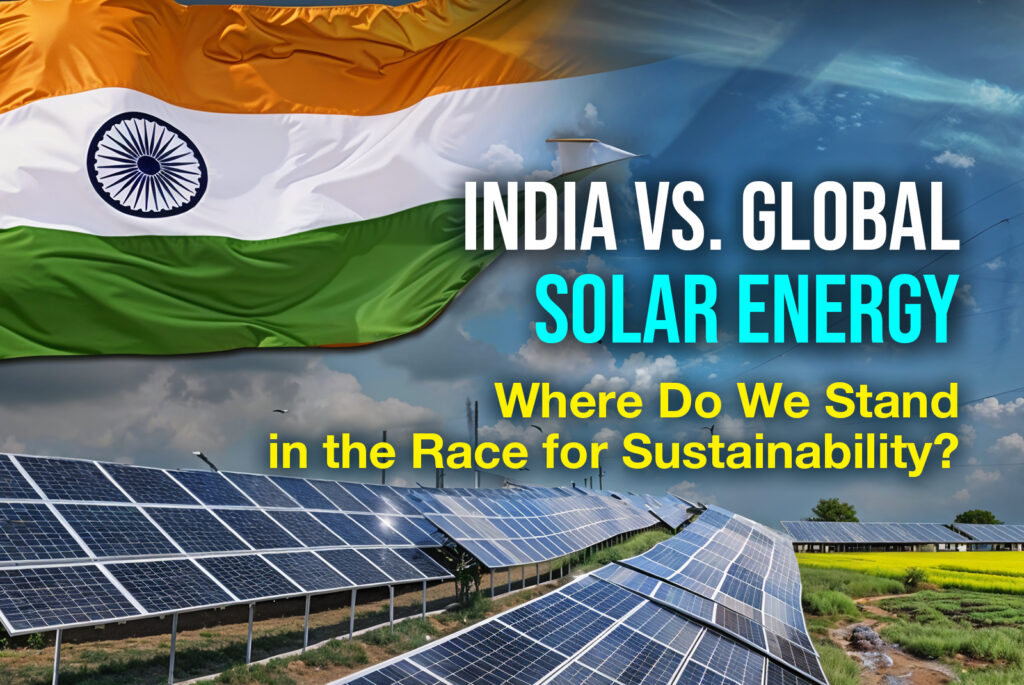Introduction: The Global Solar Boom and India’s Position
The world is undergoing a rapid transformation in the energy sector, with solar power becoming the backbone of global sustainability efforts. Countries are increasingly shifting away from fossil fuels, investing in large-scale solar farms, and integrating renewable energy into their grids. As nations set aggressive targets to meet net-zero emissions, solar energy has emerged as the fastest-growing renewable source worldwide.
India, with its abundant sunlight, ambitious policies, and aggressive renewable energy targets, has made significant strides in the solar sector. However, in comparison to global leaders like China, the United States, and the European Union, India faces challenges such as dependency on imported components, infrastructure limitations, and land acquisition hurdles. The key question remains: Is India truly on track to becoming a solar superpower, or does it still have gaps to fill in the global sustainability race?
The Global Solar Landscape: Who’s Leading the Charge?
The International Energy Agency (IEA) reports that the world added over 400 GW of new solar capacity in 2024, surpassing all previous records. The surge in solar installations is driven by technological advancements, falling costs, and strong policy support from various governments. However, the solar race is dominated by a few key players.
Top 5 Solar Power Producers (as of 2024):
- China – 550 GW (Largest solar producer and exporter of solar panels)
- European Union – 210 GW (Germany, Spain, and the Netherlands leading the transition)
- United States – 170 GW (Strong policy incentives like the Inflation Reduction Act)
- India – 80 GW (Fast-growing but faces challenges in manufacturing and grid integration)
- Japan – 78 GW (Focus on rooftop solar and smart grid solutions)
Key Global Trends in Solar Energy:
- China’s dominance: Over 80% of the world’s solar panels are manufactured in China.
- U.S. policy push: The Inflation Reduction Act (IRA) has driven record investments in American solar manufacturing and deployment.
- Europe’s rooftop solar revolution: Germany and Spain are leading in decentralized solar adoption, with a strong focus on residential and commercial installations.
- India’s large-scale solar farms: India has focused heavily on utility-scale projects, but rooftop solar adoption lags behind other nations.
India’s Solar Growth: Ambition vs. Reality
India has set ambitious renewable energy targets, including:
- 500 GW of non-fossil fuel capacity by 2030, with 280 GW expected from solar power.
- Achieving 50% electricity generation from renewable sources by 2030.
- Becoming a net-zero economy by 2070, with solar playing a key role.
Major Solar Developments in India (2024-2025):
- Adani Green Energy and Tata Power Solar are investing a combined $20 billion in solar expansion.
- The world’s largest floating solar plant (600 MW) is being developed in Omkareshwar, Madhya Pradesh.
- Reliance Industries’ solar giga factory in Gujarat is set to make India a global hub for solar manufacturing, reducing reliance on Chinese imports.
While these initiatives indicate strong momentum, India still lags behind global leaders in terms of solar manufacturing, per capita solar adoption, and energy storage integration.
Challenges Holding India Back in the Solar Race
1. Heavy Dependency on Imports
India imports over 75% of its solar panels and components from China, despite government efforts to boost domestic manufacturing under the Production-Linked Incentive (PLI) scheme. This dependence:
- Increases costs due to supply chain disruptions.
- Threatens energy security in case of geopolitical tensions.
- Limits technological innovation in India’s solar sector.
2. Land Acquisition and Infrastructure Hurdles
Unlike the U.S. and China, where vast desert lands are available for solar farms, India struggles with land scarcity due to its high population density. Many projects face legal and environmental delays, slowing solar expansion. Additionally, India’s electricity grid needs modernization to integrate large volumes of fluctuating solar power effectively.
3. Slow Growth in Rooftop Solar Adoption
While India excels in large-scale solar projects, its rooftop solar penetration is only 6%, compared to Germany’s 25%. The primary reasons for this slow adoption include:
- High upfront costs for residential installations.
- Lack of awareness and policy clarity in net metering.
- Grid instability in integrating decentralized solar power.
4. Financial and Policy Uncertainty
Despite government incentives, many solar developers struggle with high capital costs and regulatory challenges. Policy uncertainties, delayed approvals, and inconsistent subsidy schemes discourage investment in the sector.
How India Can Catch Up with Global Solar Leaders
To bridge the gap with China, the U.S., and the EU, India must focus on:
1. Scaling Up Domestic Solar Manufacturing
- Expanding production under the PLI scheme to reduce import dependency.
- Encouraging private sector investments in solar panel and battery manufacturing.
- Incentivizing research and development in high-efficiency solar technologies.
2. Accelerating Rooftop Solar Adoption
- Implementing simplified net metering policies to encourage residential solar installations.
- Offering better financial incentives such as low-interest loans and tax benefits.
- Strengthening state-level solar policies to promote commercial and industrial rooftop installations.
3. Strengthening Energy Storage & Grid Infrastructure
- Investing in energy storage solutions such as lithium-ion and flow batteries.
- Modernizing the power grid to enhance solar integration and reduce transmission losses.
- Promoting smart grid technologies and AI-driven solar forecasting.
4. Enhancing International Collaborations
- Partnering with global solar leaders for technology transfer and R&D.
- Strengthening ties with European nations and the U.S. to secure investments in India’s solar industry.
- Encouraging public-private partnerships to drive large-scale solar adoption.
Conclusion: Is India on Track to Become a Solar Superpower?
India has made remarkable progress in the solar energy sector, but major challenges remain in its path to becoming a global leader. The country’s ambitious targets, strong government policies, and increasing private sector investments provide a solid foundation for growth. However, import dependency, infrastructure bottlenecks, slow rooftop adoption, and policy hurdles must be addressed urgently.
With consistent policy support, accelerated manufacturing, and enhanced grid infrastructure, India has the potential to emerge as a solar powerhouse by 2030. If the country successfully navigates these challenges, it will not only secure its energy future but also play a pivotal role in the global clean energy transition. The next few years will be crucial in determining whether India can transform from an ambitious contender into a dominant force in the global solar landscape.

